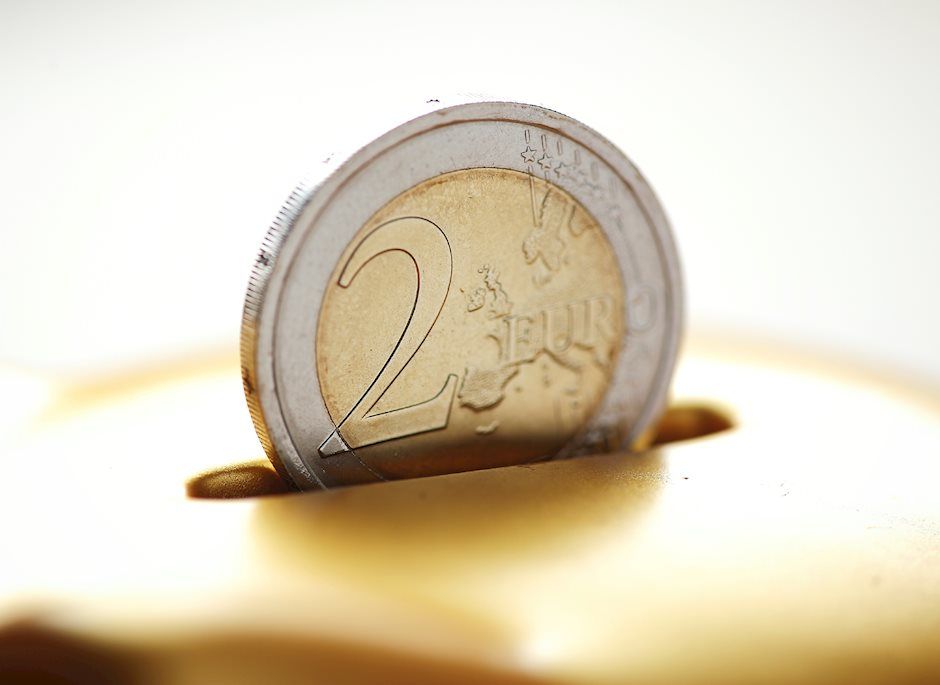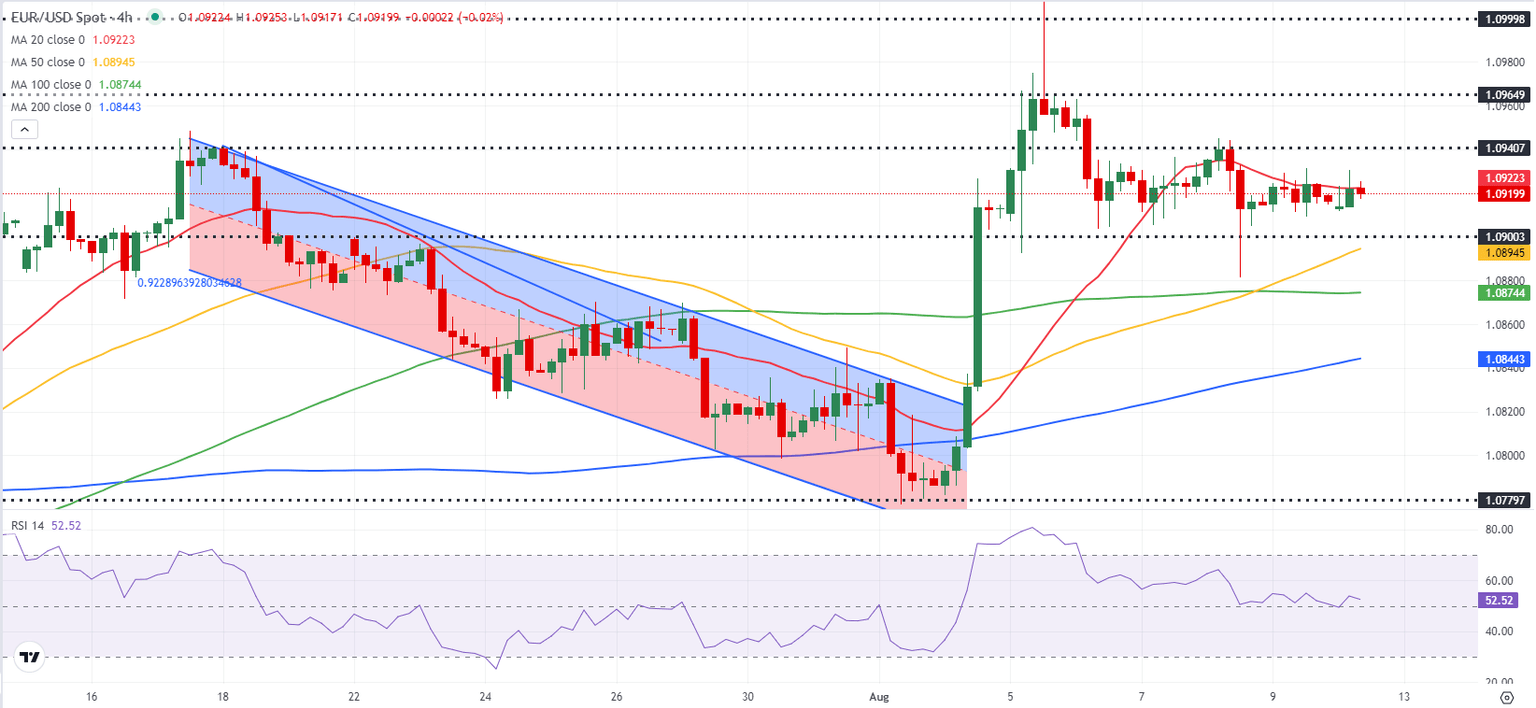EUR/USD Forecast: Euro remains in range as markets await next catalyst
- EUR/USD extends sideways grind above 1.0900 to start the new week.
- Investors keep a close eye on headlines surrounding Iran-Israel conflict.
- The economic calendar will not feature any high-tier data releases on Monday.

EUR/USD continues to move up and down in a narrow range above 1.0900 after closing the previous week virtually unchanged. The pair's technical outlook does not offer any directional clues as investors remain on the sidelines while keeping a close eye on geopolitical headlines.
Euro PRICE Last 7 days
The table below shows the percentage change of Euro (EUR) against listed major currencies last 7 days. Euro was the weakest against the New Zealand Dollar.
| USD | EUR | GBP | JPY | CAD | AUD | NZD | CHF | |
|---|---|---|---|---|---|---|---|---|
| USD | -0.06% | 0.31% | 0.50% | -1.07% | -1.27% | -1.17% | 1.23% | |
| EUR | 0.06% | 0.29% | 0.40% | -1.13% | -1.20% | -1.22% | 1.19% | |
| GBP | -0.31% | -0.29% | 0.17% | -1.40% | -1.48% | -1.50% | 0.89% | |
| JPY | -0.50% | -0.40% | -0.17% | -1.52% | -1.80% | -1.64% | 0.77% | |
| CAD | 1.07% | 1.13% | 1.40% | 1.52% | -0.17% | -0.10% | 2.14% | |
| AUD | 1.27% | 1.20% | 1.48% | 1.80% | 0.17% | -0.02% | 2.41% | |
| NZD | 1.17% | 1.22% | 1.50% | 1.64% | 0.10% | 0.02% | 2.43% | |
| CHF | -1.23% | -1.19% | -0.89% | -0.77% | -2.14% | -2.41% | -2.43% |
The heat map shows percentage changes of major currencies against each other. The base currency is picked from the left column, while the quote currency is picked from the top row. For example, if you pick the Euro from the left column and move along the horizontal line to the US Dollar, the percentage change displayed in the box will represent EUR (base)/USD (quote).
Markets turn cautious at the beginning of the week on growing fears over the Iran-Israel conflict turning into a deepening crisis in the Middle East. Although Euro Stoxx 50 Index is modestly higher in the first trading session of the week, US stock index futures struggle to gain traction.
The economic calendar will not offer any high-impact macroeconomic data releases on Monday. On Wednesday, the US Bureau of Labor Statistics will publish the Consumer Price Index (CPI) data for July.
In case geopolitical tensions escalate further in the second half of the day, major equity indexes in the US could turn south. In this scenario, the US Dollar (USD) could hold its ground against its major rivals and make it difficult for EUR/USD to gain traction. On the other hand, the pair could stretch higher if risk flows return to markets following Wall Street's opening bell.
EUR/USD Technical Analysis
The Relative Strength Index (RSI) indicator on the 4-hour chart continues to move sideways near 50, reflecting EUR/USD's indecisiveness.
First support could be seen at 1.0900 (psychological level, static level) ahead of 1.0880-1.0870, where the 100-period and the 20-day Simple Moving Averages (SMA) are located, and 1.0845 (200-period SMA).
In case the pair breaks above 1.0940 (static level), it could encounter next resistance levels at 1.0960 (static level) and 1.1000 (psychological level, static level).
Euro FAQs
The Euro is the currency for the 20 European Union countries that belong to the Eurozone. It is the second most heavily traded currency in the world behind the US Dollar. In 2022, it accounted for 31% of all foreign exchange transactions, with an average daily turnover of over $2.2 trillion a day. EUR/USD is the most heavily traded currency pair in the world, accounting for an estimated 30% off all transactions, followed by EUR/JPY (4%), EUR/GBP (3%) and EUR/AUD (2%).
The European Central Bank (ECB) in Frankfurt, Germany, is the reserve bank for the Eurozone. The ECB sets interest rates and manages monetary policy. The ECB’s primary mandate is to maintain price stability, which means either controlling inflation or stimulating growth. Its primary tool is the raising or lowering of interest rates. Relatively high interest rates – or the expectation of higher rates – will usually benefit the Euro and vice versa. The ECB Governing Council makes monetary policy decisions at meetings held eight times a year. Decisions are made by heads of the Eurozone national banks and six permanent members, including the President of the ECB, Christine Lagarde.
Eurozone inflation data, measured by the Harmonized Index of Consumer Prices (HICP), is an important econometric for the Euro. If inflation rises more than expected, especially if above the ECB’s 2% target, it obliges the ECB to raise interest rates to bring it back under control. Relatively high interest rates compared to its counterparts will usually benefit the Euro, as it makes the region more attractive as a place for global investors to park their money.
Data releases gauge the health of the economy and can impact on the Euro. Indicators such as GDP, Manufacturing and Services PMIs, employment, and consumer sentiment surveys can all influence the direction of the single currency. A strong economy is good for the Euro. Not only does it attract more foreign investment but it may encourage the ECB to put up interest rates, which will directly strengthen the Euro. Otherwise, if economic data is weak, the Euro is likely to fall. Economic data for the four largest economies in the euro area (Germany, France, Italy and Spain) are especially significant, as they account for 75% of the Eurozone’s economy.
Another significant data release for the Euro is the Trade Balance. This indicator measures the difference between what a country earns from its exports and what it spends on imports over a given period. If a country produces highly sought after exports then its currency will gain in value purely from the extra demand created from foreign buyers seeking to purchase these goods. Therefore, a positive net Trade Balance strengthens a currency and vice versa for a negative balance.
Premium
You have reached your limit of 3 free articles for this month.
Start your subscription and get access to all our original articles.
Author

Eren Sengezer
FXStreet
As an economist at heart, Eren Sengezer specializes in the assessment of the short-term and long-term impacts of macroeconomic data, central bank policies and political developments on financial assets.


















